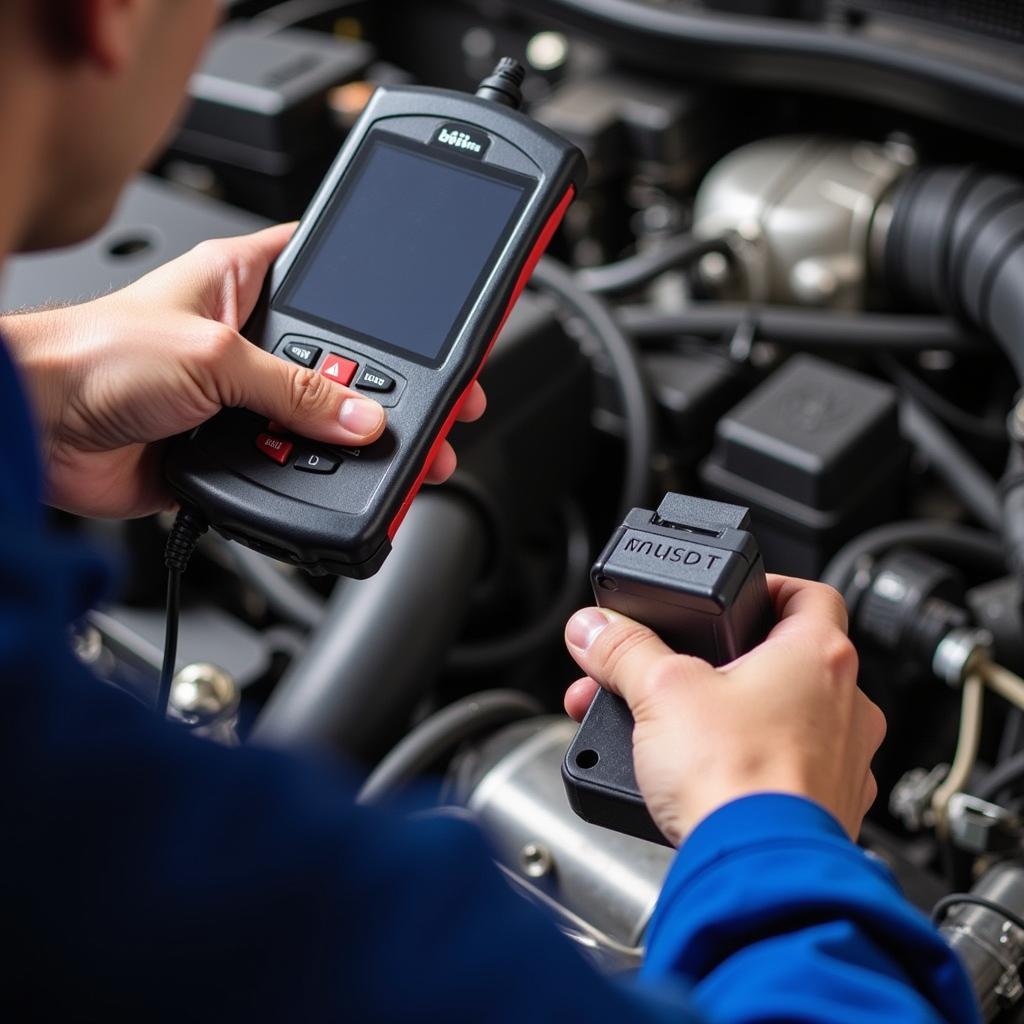A car diagnostic test, also known as a car health check, is like a window into your vehicle’s inner workings. It uses a specialized tool, often called an OBD-II scanner, to communicate with your car’s computer system. This system, known as the Engine Control Unit (ECU), continuously monitors various components and functions within your car, collecting data from numerous sensors.
But what exactly does a diagnostic test reveal? And why is it so crucial for car owners to understand its significance? Let’s delve deeper.
Unmasking the Mysteries: Deciphering Your Car’s Language
Think of a diagnostic test as a conversation with your car. Your car speaks through various sensors, and the OBD-II scanner acts as the interpreter, translating complex data into understandable codes.
These codes, displayed on the scanner’s screen, hold the key to understanding your car’s health. They can pinpoint a wide range of issues, from minor hiccups to potentially major problems that require immediate attention.
 Car diagnostic test in progress
Car diagnostic test in progress
The Power of Prevention: Why Diagnostic Tests Are Essential
Regular diagnostic tests can save you from costly repairs and unexpected breakdowns. Here’s how:
- Early Detection: Diagnostic tests can detect problems in their initial stages, even before you notice any symptoms. This allows for timely intervention and prevents minor issues from escalating into major, expensive repairs.
- Accurate Diagnosis: Gone are the days of guesswork in car repairs. Diagnostic tests provide accurate information, eliminating unnecessary repairs and ensuring that the root cause of the problem is addressed.
- Improved Performance: By identifying issues that affect your car’s performance, diagnostic tests pave the way for smoother rides, improved fuel efficiency, and reduced emissions.
Beyond the Codes: What a Diagnostic Test Can Reveal
A diagnostic test can unveil a wide spectrum of issues, encompassing:
- Engine Performance: Misfires, fuel system problems, ignition system faults, and emission control issues.
- Transmission: Problems with shifting, slippage, or fluid levels.
- Brakes: Issues with the ABS system, brake fluid levels, or brake pad wear.
- Airbags: Faults in the airbag deployment system.
- Emissions: Problems with the catalytic converter or other emission control components.
Understanding the Types of Diagnostic Trouble Codes
The codes displayed on the OBD-II scanner are categorized into four main types:
- Powertrain (P-Codes): These codes relate to the engine, transmission, and associated components.
- Body (B-Codes): These codes pertain to body electronics, such as power windows, central locking, and lighting.
- Chassis (C-Codes): These codes are related to the chassis systems, including the ABS, suspension, and steering.
- Network & Communication (U-Codes): These codes indicate problems with the communication network between the various modules in your car.
 OBD-II scanner displaying diagnostic trouble codes
OBD-II scanner displaying diagnostic trouble codes
Debunking the Myths: Diagnostic Tests vs. Mechanic Expertise
While diagnostic tests provide invaluable insights, they shouldn’t be mistaken as a replacement for a skilled mechanic. These tests offer a starting point for diagnosis, but a qualified mechanic brings their experience, knowledge, and specialized tools to interpret the results accurately and recommend the most effective course of action.
“Diagnostic tests are powerful tools, but they don’t tell the whole story,” says John Smith, Senior Automotive Technician at XYZ Auto Repair. “A mechanic’s expertise lies in understanding the nuances, correlating the codes with the car’s history and symptoms, and then devising the most appropriate repair strategy.”
Empowering Car Owners: The Importance of Diagnostic Literacy
Understanding the basics of car diagnostic tests empowers you as a car owner. It enables you to:
- Communicate effectively with your mechanic: You’ll be better equipped to understand the issues flagged by the test and discuss potential solutions with your mechanic.
- Make informed decisions: Understanding the severity of the problems detected can help you decide on the urgency and scope of repairs.
- Take proactive measures: Regular diagnostic tests coupled with timely maintenance can help you avoid costly repairs and prolong the life of your car.
Conclusion
A car diagnostic test is an indispensable tool for every car owner. It provides a glimpse into the heart of your vehicle, enabling early detection of problems, accurate diagnosis, and informed decision-making.
By embracing the power of diagnostic tests and partnering with a skilled mechanic, you can ensure the health, longevity, and optimal performance of your car. Don’t wait for a warning light to illuminate your dashboard; stay ahead of potential issues and enjoy a smoother, safer, and more enjoyable driving experience.
Need help deciphering your car’s diagnostic codes? Contact us on WhatsApp: +1(641)206-8880, or Email: [email protected]. Our team of car diagnostic experts is available 24/7 to assist you.

Leave a Reply